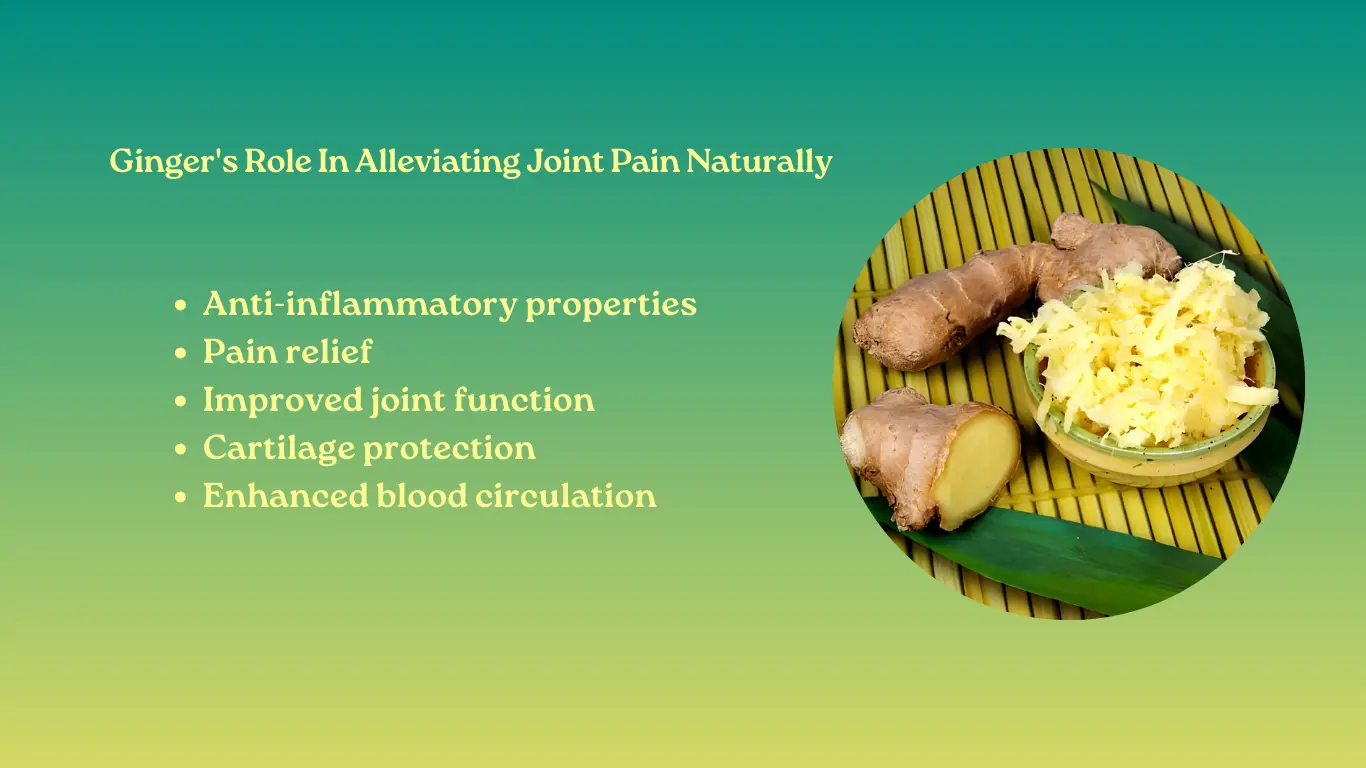How To Use Ginger For Joint Pain Relief? Unlock Its Power!
Curious about ginger’s effectiveness for joint pain relief? Discover expert tips on dosage, preparation methods, and usage techniques in our comprehensive guide. Learn how to harness ginger’s natural properties for soothing joint discomfort effectively.

Disclaimer: This article has been generated with the assistance of AI tools. While our research team has fact-checked the content, readers should independently verify information for accuracy and reliability.
Ginger, a common spice known for its distinctive flavor, has been used for centuries in traditional medicine to treat various ailments, including joint pain. There has been a significant increase in the number of people suffering from joint pain in recent years. As people search for natural and effective ways to manage their symptoms, ginger has gained attention as a potential solution.
The active compounds in ginger, such as gingerols and shogaols, have been shown to possess anti-inflammatory and pain-relieving properties. These properties make ginger a promising natural remedy for those seeking to alleviate joint pain and improve their overall quality of life.
Ginger For Joint Pain Relief: Does It Work?

Ginger has long been touted as a natural remedy for joint pain relief, but does the evidence support its efficacy? Research suggests that ginger does possess anti-inflammatory properties that can help alleviate joint discomfort associated with conditions like osteoarthritis. Studies have shown ginger can modestly reduce joint pain and stiffness compared to placebo.
However, the effects are typically mild to moderate, and ginger may not be as potent as prescription anti-inflammatory medications. Still, for those seeking a natural approach, ginger may be worth trying under the guidance of a healthcare provider. The convenience and relatively low risk make it a reasonable complementary option for managing arthritis and joint pain.
Can Ginger Be Used As A Painkiller?
While ginger may not be as potent as conventional painkillers, research suggests that it can be effective in reducing pain and inflammation associated with joint conditions like osteoarthritis and rheumatoid arthritis. A study published in the Journal of Medicinal Food found that ginger extract significantly reduced knee pain and stiffness in individuals with osteoarthritis.
Ginger works by inhibiting the production of certain inflammatory compounds in the body, such as prostaglandins and leukotrienes. By reducing inflammation, ginger can help alleviate pain and improve joint mobility. However, it’s important to note that while ginger can be helpful, it may not provide complete pain relief and should be used in conjunction with other treatment methods as recommended by a healthcare professional.
How Much Ginger Should I Take For Pain?
The optimal dosage of ginger for pain relief can vary depending on the individual and the severity of their condition. In general, studies have used daily doses ranging from 500 milligrams to 2 grams of ginger extract. However, it’s crucial to start with a lower dose and gradually increase it to assess your tolerance and avoid potential side effects.
When using ginger supplements, it’s essential to follow the recommended dosage on the product label. If you are considering using ginger as a pain relief option, it’s always best to consult with a healthcare professional to determine the appropriate dosage for your specific needs and to ensure that the supplement will not have any kind of potential interaction with the medication you might be taking.
Is Ginger Or Turmeric Better For Arthritis?
Both ginger and turmeric have been shown to have anti-inflammatory and pain-relieving properties, making them potentially beneficial for individuals with arthritis. A compound called curcumin is found in Turmeric that has been renowned for its anti-inflammatory effects.
While both spices may be helpful, the choice between ginger and turmeric may depend on individual preferences and responses. Some people may find ginger to be more effective for their joint pain, while others may prefer turmeric. It’s also possible to use both spices together, as they have complementary effects and can be easily incorporated into meals or consumed as supplements.
Conclusion
Ginger offers a natural and promising approach to managing joint pain and inflammation. By incorporating ginger into your daily routine through teas, supplements, or culinary uses, you may experience a reduction in joint discomfort and an improvement in overall mobility.
While ginger can be effective, it’s important to remember that it should be used as part of a comprehensive treatment plan, which may include other lifestyle modifications like exercise, weight management, and a balanced diet. It’s also essential to consult with a healthcare professional before starting any new supplement regimen to ensure safety and appropriate dosage.
In the battle against joint pain, both ginger and turmeric have shown potential benefits. Ultimately, the choice between the two may come down to personal preference and individual results.
Has your journey led you to discover the power of natural remedies like ginger or turmeric for joint pain relief? We’re all ears! Share your stories and insider tips in the comments below – your wisdom might just be the missing piece someone needs to break free from discomfort and reclaim their active lifestyle. Let’s inspire and empower each other on the path to healthier, happier joints!
References
- National Institute Of Health(n.d) Osteoarthritis available online at: https://www.niams.nih.gov/health-topics/osteoarthritis
- Medline Plus(n.d) Rheumatoid arthritis available online at: https://medlineplus.gov/ency/article/000431.htm
- MDPI(n.d) Zingiber Officinale Roscoe: The Antiarthritic Potential of a Popular Spice—Preclinical and Clinical Evidence available online at: https://www.mdpi.com/2072-6643/16/5/741
Alex Milan
Alex Milan is a licensed osteopath and acupuncturist based in United States. He graduated from the British School of Osteopathy in 2017, where he received extensive training in osteopathic techniques for treating musculoskeletal conditions. Alex is passionate about providing patients with holistic, drug-free pain relief and enabling people to live active, healthy lives. He utilizes osteopathic manipulative techniques along with acupuncture and lifestyle advice to address the root causes of pain and dysfunction in the body. With expertise in areas including sports injuries, back and neck pain, headaches, and repetitive strain injuries, Alex has helped numerous patients find relief from pain and return to their regular activities.
